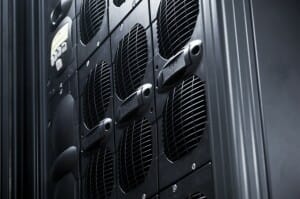
When an Energy Efficient UPS is Inefficient
Did You Know a Highly Efficient UPS Can Help Cut Energy Costs?
However, if you base a UPS’s efficiency solely on its energy efficiency rating, you’re making a huge mistake. UPS efficiency ratings are often misunderstood, which is why it’s essential you understand how they work before your next UPS purchase.
How to Work Out Energy Efficient Ratings
The energy efficiency rating of a UPS is usually represented in the form of a percentage. The value indicates how much of the original incoming utility power is used to power your load versus the amount lost to operate the UPS. For instance, a UPS with a 90 percent energy efficiency rating indicates 90 percent of the original incoming power is powering your load, while 10 percent is being lost to operate the UPS. Given this, it’s easy to conclude that a UPS with a higher energy efficiency rating should operate more efficiently. However, in most cases, the energy efficiency rating only tells a small part of the story.
Understanding the UPS Efficiency Curve

A UPS does not always operate as efficiently as its rating suggests. Instead, its efficiency follows a curve based on your utilization rating. If the UPS is operating at 100 percent capacity, it will run as efficiently as its rating implies. However, if your UPS is operating at a lower capacity, as most do, the equation changes. Your UPS loses energy in two ways – proportionally and fixed. Proportional losses occur in the form of heat-dissipation and are directly tied to the size of your load. Conversely, fixed losses remain constant regardless of how much current is running through your UPS. When a UPS is running a partial load, fixed losses have a more significant impact on its efficiency. This is especially important when you consider that most facilities operate their UPS’s at less than half of their running capacity.
The following example illustrates this point well. For this case, we consider two different UPS’s:
* UPS A has a 96 percent efficiency rating * UPS B has a 94 percent efficiency rating

Look at the following graphic to see how efficiently each UPS operates at various levels of their load capacities.
Source: emersonnetworkpower.com
What do you observe? When operating with a full load, UPS A is clearly the more energy efficient UPS system. However, when operating at a capacity lower than 50 percent, we see that UPS B is actually the more energy efficient UPS system despite its lower energy efficiency rating. That’s because when the two UPS’s are at full capacity, UPS A, with lower proportional loss, operates more efficiently. However, when they dip below 50 percent running capacity, UPS A’s lower proportional loss is overshadowed by its higher fixed loss. At that point, UPS B becomes the more efficient system. The moral of the story is that ratings don’t paint an accurate picture. Instead, you need to consider the real-life scenario in which you’ll use your UPS, which is almost always below 50 percent of its load capacity. Ask your UPS provider to show you power supply efficiency curves, like the graphic above, of prospective UPS systems to determine which one will be the most efficient in your facility.
How a UPS Bypass Improves Efficiency
Some UPS’s are built with an operation function called UPS bypass, also known as eco-mode. Running on UPS bypass mode can dramatically increase your UPS’s efficiency, sometimes up to 99 percent. However, running on bypass can come with a trade off – depending on the manufacturer, bypass can affect the reliability and functionality of your UPS. So, while your system is running more efficiently, it’s not necessarily running as effectively. The pros and cons of bypass systems vary widely depending on each UPS and your facility, so it’s always a good idea to ask your UPS provider, like Quality Power Solutions, if they think a certain system is compatible with your facility. If your facility is compatible with a system that offers UPS bypass mode, be sure to inquire as to when it’s safe to operate in this mode.
Maintaining Your UPS’s Efficiency
We often tell our customers that purchasing a UPS is only a portion of the total lifecycle cost of ownership. That’s because, in order to maintain your system’s efficiency, you need to give it the proper maintenance. We recommend scheduling regular UPS maintenance at least twice per year to ensure your UPS is healthy and running efficiently. In addition to these crucial checks, a trained technician will also investigate and test many of the internal components that are prone to failure, helping your UPS continue to operate efficiently. This can include cleaning out dirty fans and air filters, as well as ensuring your UPS’s internal connections. For a full overview of how UPS maintenance checks can increase your facility’s uptime and help your UPS run more efficiently, check out this post.
Ok, you knew that if you wanted to cut energy costs, an energy efficient UPS is a must. Now you know that ratings only tell part of the story. To avoid those ratings throwing you a curve, look at the power supply efficiency curves first. Be sure to also check with your UPS provider to find out when it’s best to run a UPS bypass mode, and what type of maintenance plan is ideal for your facility.
Need Help With Finding the Most Efficient UPS? Contact QPS Today.
Contact Us
General questions about new or existing service.
Published on Sep 24 2014
Last Updated on Oct 17 2023